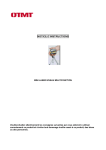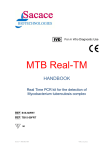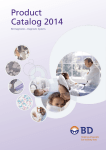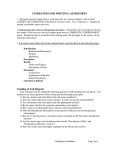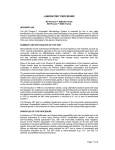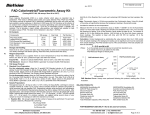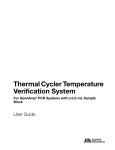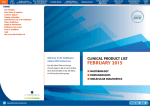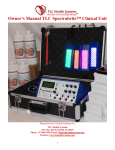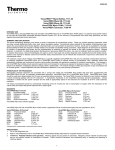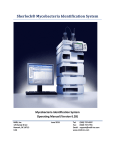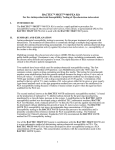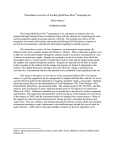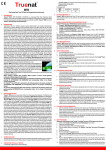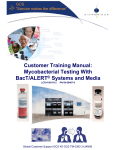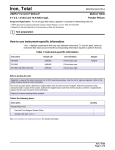Download BACTEC MGIT 960 SEEDED CULTURE
Transcript
BACTEC™ MGIT™ 960 System I. PRINCIPLE From 1985 to 1992, the number of reported cases of tuberculosis increased 18%. This infectious disease still kills an estimated 3 million persons a year worldwide, making it the leading infectious disease cause of death.1 Between 1981 and 1987, AIDS case surveillance indicated that 5.5% of patients with AIDS had disseminated nontuberculous mycobacterial infections; e.g., Mycobacterium avium complex (MAC). By 1990, the increased number of disseminated nontuberculous mycobacterial infections resulted in a cumulative incidence of 7.6%.2 In addition to the resurgence of Mycobacterium tuberculosis (MTB), multidrugresistant MTB (MDR-TB) has become an increasing concern. Laboratory delays in the growth, identification and reporting of these MDR-TB cases has contributed, at least in part, to the spread of the disease.3 The US Centers for Disease Control and Prevention (CDC) have recommended that every effort must be made for laboratories to use the most rapid methods available for diagnostic mycobacteria testing. These recommendations include the use of both a liquid and a solid medium for mycobacterial culture.3,4 The BBL™ MGIT™ Mycobacteria Growth Indicator Tube contains 7 mL of modified Middlebrook 7H9 Broth base.5,6 The complete medium, with BACTEC™ MGIT™ 960 Growth Supplement and BBL™ MGIT™ PANTA™ Antimicrobic mixture, is one of the most commonly used liquid medium for the cultivation of mycobacteria. The BACTEC™ MGIT™ 960 System is designed for the rapid detection of mycobacteria in all types of clinical specimens except blood and urine. The system includes a liquid culture medium (BBL™ MGIT™ Mycobacteria Growth Indicator Tube), a growth supplement and an antibiotic mixture (BBL™ MGIT™ PANTA™). The BACTEC™ MGIT™ Growth Supplement provides substances essential for the growth of mycobacteria. BBL MGIT PANTA contains a mixture of antimicrobial agents used to suppress the growth of contaminating bacteria. A fluorescent compound is embedded in silicone on the bottom of each of the MGIT broth tubes. This compound is sensitive to the presence of oxygen dissolved in the broth. Initially, the large amount of dissolved oxygen quenches the emissions from the compound and little fluorescence can be detected. Later, actively respiring microorganisms consume the oxygen and allow the fluorescence to be detected. 7mlclsi.doc Page 1 of 11 The BACTEC™ MGIT™ 960 System monitors the tubes for increasing fluorescence. Analysis of the fluorescence is used to determine if the tube is instrument-positive; i.e., the test sample contains viable organisms. Culture tubes which remain negative for a minimum of 42 days (up to 56 days) and which show no visible signs of positivity are removed from the instrument as negatives. II. MATERIALS A. MEDIA 1) BBL™ MGIT™ Mycobacteria Growth Indicator Tube: Each tube contains 110 μL of fluorescent indicator and 7 mL of broth. The indicator contains Tris 4, 4-diphenyl-1, 10-phenanthroline ruthenium chloride pentahydrate in a silicone rubber base. The tubes are flushed with 10% CO2 and capped with polypropylene caps. Each tube contains the following active ingredients: Modified Middlebrook 7H9 Broth Base Casein peptone 2) BACTEC™ MGIT™ 960 Supplement Kit: Each kit contains: • 6 vials each containing 15 mL of BACTEC MGIT Growth Supplement with the following active ingredients: Bovine Albumin Catalase • Dextrose Oleic Acid Polyoxyethylene Stearate 6 vials of BBL™ MGIT™ PANTA™ Antimicrobic Mixture: Each vial contains the following lyophilized mixture of antimicrobial agents: Polymyxin B Amphotericin B Naladixic Acid Trimethoprim Azlocillin B. MATERIALS REQUIRED BUT NOT PROVIDED Biological Safety Cabinet, Vortex mixer, 37°C Incubator, Lowenstein-Jensen Medium or solid medium of choice, Middlebrook 7H9 Broth, sterile tubes with glass beads, 1 mL sterile pipettes, 0.5 McFarland turbidity standard, sterile tubes, sterile saline, adjustable 1000 μL pipette, sterile tubes, Quality Control organisms (Mycobacterium tuberculosis ATCC™ 27294, M. kansasii ATCC 12478, M. fortuitum ATCC 6841). C. INSTRUMENT When microorganisms are present, nutrients in the BBL MGIT Mycobacteria Growth Indicator Tube are metabolized resulting in the depletion of oxygen in the medium. 7mlclsi.doc Page 2 of 11 Analysis of the rate of oxygen decrease as measured by increasing fluorescence enables the BACTEC MGIT 960 to determine if the tube is instrument positive. A positive determination indicates the presumptive presence of microorganisms in the tube. III. SPECIMEN A. TYPE BACTEC MGIT Mycobacteria Growth Indicator Tubes are to be used for culture of digested and decontaminated clinical specimens (except urine) and sterile body fluids (except blood). B. PROCESSING POTENTIALLY INFECTIOUS TEST SPECIMEN. Observe "Universal Precautions"7 and institutional guidelines when handling and disposing of infectious materials. 1. Sputum or other respiratory specimens must be digested, decontaminated and concentrated prior to inoculation into BBL MGIT tubes. The N-acetyl-Lcysteine-sodium hydroxide method is recommended. Alternatively, the BBL™ MycoPrep™ Kit may be used for processing the specimen. 2. Processing of non-respiratory specimens other than blood and urine should be performed according to the Clinical Microbiology Handbook or the CDC's Public Health Mycobacteriology: A Guide for the Level III Laboratory.6,8 C. SPECIMEN LABELING 1. Each specimen should be labeled with the appropriate information: • • • • • Patient' Name Hospital number (Patient ID) Patient's location (room and bed #) Date and time of collection Site of specimen 2. Each request slip should also have all the above information. IV. QUALITY CONTROL A. MEDIA Upon receipt of a new shipment or lot number of MGIT tubes, it is suggested that suspensions of the ATCC control organisms shown in the table below be prepared in Middlebrook 7H9 Broth. Species ATCC™ Dilution of 0.5 Days to 7mlclsi.doc Page 3 of 11 Number M. tuberculosis M. kansasii M. fortuitum 27294 12478 6841 McFarland in Saline 1:500 1:50000 1:5000 Instrument Positivity 6 - 10 6 - 11 1-3 1. From solid media cultures less than 15 days old, prepare a suspension in Middlebrook 7H9 Broth. 2. Allow the suspension to sit for 20 min. 3. Transfer the supernatant to another empty, sterile tube and allow to sit for an additional 15 min. 4. Transfer the supernatant to another empty, sterile tube. 5. Adjust the suspension to a turbidity comparable to a McFarland No. 0.5 standard. 6. Dilute the control organism suspensions following the dilution scheme outlined in the above table. 7. Inoculate the BBL MGIT tubes following the "Inoculation of MGIT Tubes" procedure. The BBL MGIT tubes should be detected as instrument positive within the time frame shown in the above table. If the QC MGIT tubes do not give the expected results, do not use the remaining tubes until you have contacted Technical Services at (800)638-8663 (United States only). B. INSTRUMENT The following procedures should be performed at the start of each day's testing and recorded on the maintenance log. 1. Check temperature readout of each drawer by reading the Temperature QC Tubes. The manual readings should be within +1.0°/-2.0° C of 37° C. 2. Verify that each drawer is currently within 1.5°C of the manual reading for each of the drawers by pressing the "temperature" soft key. 3. Press the "maintenance" soft key. Press the "test indicators" soft key. 4. Press the "test drawer indicators" soft key. All three external indicator lamps on all three drawers should light, as well as the instrument Alarm indicator. 5. Open Drawer A. The soft key functions appear to allow tests of the station status LEDs. (a) Press the "test green LEDs" soft key. All of the green LEDs at all the stations should light. If any does not, block the station(s) as described in Section 7mlclsi.doc Page 4 of 11 6.2.3.2 - Block Station of the BACTEC MGIT 960 User's Manual. Press the "test green LEDs" soft key again to extinguish the green LEDs. (b) Press the "test red LEDs" soft key. All of the red LEDs at all the stations should light. If any does not, block the station(s) as described in Section 6.2.3.2 - Block Station of the BACTEC MGIT 960 User's Manual. Press the "test red LEDs" soft key again to extinguish the red LEDs. 6. Repeat the tests of red and green station status LEDs for Drawers B and C. 7. Check the printer's paper supply. If the paper supply is low or exhausted, replace the paper as explained in the manufacturer's operating instructions. (a) Clean and replace the filters monthly. Refer to the User's Manual, Section 6.2.2. V. PROCEDURE A. GENERAL SAFETY CONSIDERSTIONS IMPORTANT NOTE: Please be sure to follow Good Laboratory Practices and Universal Precautions7 at all times during the test procedure. All materials should be disposed of properly as required by your institution. 1. Biosafety Level 2 practices, containment equipment and facilities are recommended for preparing acid-fast stains and for culturing clinical specimens. For activities involving the propagation and manipulation of Mycobacterium tuberculosis or Mycobacterium bovis growth in culture, Biosafety Level 3 practice, containment equipment, and facilities are required as recommended at the CDC. 2. Perform all specimen processing and positive tube staining or subculturing in a Biological Safety Cabinet. Appropriate protective clothing, including glove and masks, should be worn. 3. DO NOT USE tubes showing evidence of contamination or damage. Discard any tubes if they appear unsuitable. 4. Dropped tubes should be examined carefully. If damage is seen, the tube should be discarded, 5. Before discarding, place all contaminated BBL MGIT tubes and other materials in a puncture proof container. Autoclave and dispose of according to your facility's procedure. B. PROCESSING NEW CULTURES 1. INOCULATION OF MGIT TUBES: BBL MGIT Tubes (7 mL, Cat no. 245122) must be used with a BACTEC MGIT 960 instrument. 7mlclsi.doc Page 5 of 11 a. Reconstitute a lyophilized vial of BBL MGIT PANTA antibiotic mixture with 15 mL of BACTEC MGIT Growth Supplement. b. Label the MGIT tube with the specimen number. c. Unscrew the cap and aseptically add 0.8 mL of MGIT Growth Supplement/MGIT PANTA antibiotic mixture. For best results, the addition of MGIT Growth Supplement/MGIT PANTA antibiotic mixture should be made just prior to specimen inoculation. d. Add 0.5 mL of the digested, decontaminated, and concentrated specimen suspension. Also add a drop (0.1 mL) of specimen to a 7H10 agar plate or other mycobacterial solid agar or egg-based medium. e. Tightly recap the tube and mix well. f. Tubes entered into the instrument will be automatically tested for the duration of the recommended 42-day testing protocol. For specimens in which mycobacteria with different incubation requirements are suspected, a duplicate MGIT tube can be set up and incubated at the appropriate temperature; e.g., 30° or 42° C. Inoculate and incubate at the required temperature. These tubes must be manually read (refer to the BACTEC™ MGIT™ 960 User's Manual). For specimens suspected of containing Mycobacterium haemophilum, a source of hemin must be introduced into the tube at the time of inoculation and the tube incubated at 30° C. Aseptically place one strip of BBL™ Taxo™ X factor strip into each MGIT tube requiring the addition of hemin prior to inoculation of specimen (see "Availability"). These tubes must be manually read (refer to the BACTEC™ MGIT™ 960 User's Manual). g. Positive tubes, identified by the BACTEC™ MGIT™ 960 instrument, should be subcultured and an acid fast smear prepared. All quality control testing, reprocessing, smear preparation, subculturing, etc., of presumptive positive tubes must be performed using BSL III practices and containment facilities. 2. ENTERING TUBES INTO THE INSTRUMENT a. Accession Barcoding Disabled 1) Take the new culture tubes to the instrument. Open the desired drawer. 2) Press the "tube entry" soft key. 3) The barcode scanner turns on and the barcode icon appears in the main body of the display. Place the tube in the alignment block in front of the scanner with the barcode label facing the scanner. If necessary, rotate the tube slightly so the scanner can read the label. The system beeps once to indicate a good scan. 7mlclsi.doc Page 6 of 11 4) The assigned station and the scanned sequence number are shown in the main body of the display. The assigned station LEDs in the drawer illuminate GREEN. 5) Carefully and completely insert the tube into the designated station. 6) Repeat steps 3 - 5 for each new tube to be entered. NOTE: Tubes should not be twisted or turned once they are entered into the appropriate stations. Tubes should only be removed if they are positive, negative or reassigned due to a bad station. b. Accession Barcoding Enabled 1) Take the new culture tubes to the instrument. Open the desired drawer. 2) Press the "tube entry" soft key. 3) The barcode scanner turns on and the barcode icon appears in the main body of the display shows an arrow pointing to the upper barcode (the tube sequence number). Place the tube in the alignment block in front of the scanner with the barcode label facing the scanner. If necessary, rotate the tube slightly so the scanner can read the label. The system beeps once to indicate a good scan. 4) The icon in the main body of the display shows an arrow pointing to the lower barcode (the accession number). Scan either the accession barcode label, or press the "no accession barcode available" soft key. 5) The assigned station, the scanned sequence number and accession number are shown in the main body of the display. The assigned station LEDs in the drawer illuminate GREEN. 6) Carefully and completely insert the tube into the designated station. 7) Repeat steps 3 - 5 for each new tube to be entered. NOTE: Tubes should not be twisted or turned once they are entered into the appropriate stations. Tubes should only be removed if they are positive, negative or reassigned due to a bad station. 3. POSITIVE CULTURES a. The system will indicate the presence of presumptive positive vials in several ways: 1) The POSITIVE indicator lamp on the front of the drawer illuminates, 2) The tube count for each drawer, next to the filled circle with a plus sign icon, increments in the Summary window display, 3) When the drawer is opened, the "remove positive tubes" soft key appears on the screen, and 4) The audible alert sounds until the condition is acknowledged. b. To Remove the Positive Tubes: 1) Press the SILENCE ALARM key to quiet the audible alarm. Open the appropriate drawer. 2) Press the "remove positive tubes" soft key. 7mlclsi.doc Page 7 of 11 3) All the positive stations illuminate with FLASHING GREEN, FLASHING RED indicators. Remove one of the positive tubes. 4) The barcode scanner turns on and the barcode icon appears in the main body of the display. Scan the positive tube's barcode label. The LEDs at this station extinguish. 5) Repeat Steps 4 - 5 to remove additional positive tubes. The POSITIVE indicator on the front of the drawer and at the top of the instrument will not extinguish until all positive vials are removed. 6) When all positive tubes are removed, the instrument beeps three times, the barcode scanner turns off, and the "ok" icon appears in the main body of the display. NOTE: All instrument positive tubes should be stained for AFB and subcultured upon removal from the instrument. Tubes should remain at room temperature while they are out of the instrument. c. To Return 'Smear Negative' Positive Tubes: 1) If a presumptive positive tube is determined to be smear-negative for either mycobacteria or contaminants, the tube should be re-entered into the instrument within five hours of its removal. 2) To return a smear-negative "positive" tube to the instrument: a) Open the drawer. b) Press the "tube entry" soft key. c) Scan the tube barcode label d) Place the tube in the indicated station which may differ from the original station. • Previous data are retained only if: The tube is returned within the required time limit (5 hrs.); the barcode sequence number label is scanned to re-enter the tube; or the tube is returned to the same instrument from which it was removed. 4. NEGATIVE CULTURES a. Negative cultures exist as ongoing negatives (in protocol) or out-of-protocol negatives. Notification of these conditions include: 1) Ongoing Negatives - In the Summary region of the display, the ongoing tube count for each drawer appears next to the filled circle icon, 2) Out-of-protocol Negatives - In the Summary region of the display, the tube count for each drawer appears next to the filled circle with a minus () sign icon, and 3) The negative indicator light for the drawer(s) illuminates. b. To Remove Out-of-Protocol Negatives: 1) Open the appropriate drawer. 2) Press the "remove negative tubes" soft key. 3) All the final negative stations illuminate with FLASHING GREEN indicators. 7mlclsi.doc Page 8 of 11 4) The barcode scanner turns on and the barcode icon appears in the main body of the display, signaling that the instrument is ready to read a tube barcode sequence number. 5) To remove all negative tubes (batch removal), press the "remove negatives - batch" soft key. Remove all the tubes in the indicated stations. The barcode scanner turns off, so that barcode labels cannot be scanned. Do not close the drawer until all of the tubes in the FLASHING GREEN stations have been removed. When all negative tubes are removed, press the "ok" soft key. 6) To remove negatives one at a time, remove the de- sired tube and scan the barcode label. Continue to scan and remove all the desired individual negative tubes. 7) When all negative tubes are removed, the instrument beeps three times, and the "ok" icon appears in the main body of the display. 5. PROCESSING OF POSITIVE MGIT TUBE(s): NOTE: All steps should be performed in a biological safety cabinet. 1) Remove the positive MGIT tube from the instrument and transport to an area using BSL III practices and containment facilities. 2) Using a sterile transfer pipette, remove an aliquot from the bottom of the tube (approx. 0.1 mL) for stain preparations (AFB and Gram stains), 3) Inspect smear preparations. Report preliminary results only after acidfast smear evaluation. 4) Follow the established procedure(s) for reporting results. Recommended actions may be: a) If AFB positive, subculture to solid media and report as: instrument-positive, AFB-positive, ID pending. Subculture and identify organisms according to your laboratory protocol. b) If microorganisms other than acid-fast bacilli are present, report as: instrument-positive, AFB-negative, Contaminated. Refer to the BACTEC MGIT 960 User's Manual, Appendix E for tube decontamination procedure. c) If no microorganisms are present on the smear, re-enter the tube into the instrument as an ongoing negative and allow the vial to complete testing protocol. No reportable result. IV. LIMITATIONS Recovery of mycobacteria in the BBL MGIT tube is dependent on the number of organisms present in the specimen, specimen collection methods, patient factors such as presence of symptoms, prior to treatment and the method of processing. Decontamination with the N-acetyl-L-cysteine-Sodium hydroxide (NALC-NaOH) method is recommended. Other decontamination methods have not been tested in conjunction with the BBL MGIT medium. Digestant/decontaminant solutions may have harmful effects on mycobacteria. 7mlclsi.doc Page 9 of 11 Colony morphology and pigmentation can only be determined on solid media. Mycobacteria may vary in acid-fastness depending on strain, age of culture and other variables. The consistency of microscopic morphology in BBL MGIT medium has not been established. An AFB smear-positive BBL MGIT tube can be subcultured, to both selective and nonselective mycobacterial media, for isolation to perform identification and susceptibility testing. BBL MGIT tubes which are instrument-positive may contain other non-mycobacterial species. Non-mycobacterial species may overgrow mycobacteria present. Such MGIT tubes should be re-decontaminated and re-cultured (refer to the BACTEC™ MGIT™ 960 User's Manual). Reprocessing is strongly recommended if the original specimen source cannot be easily re-collected; e.g., tissue specimen. BBL MGIT tubes which are instrument-positive may contain one or more species of mycobacteria. Faster growing mycobacteria may be detected prior to slower growing mycobacteria; therefore, it is important to subculture positive MGIT tubes to ensure proper identification of all mycobacteria present in the sample. Due to the richness of the BBL MGIT broth and to the non-selective nature of the MGIT indicator, it is important to follow the stated digestion/decontamination procedure to reduce the possibility of contamination. Adherence to procedural instructions, which includes use of recommended inoculum volume (0.5 mL) is critical for optimum recovery of mycobacteria. The use of BBL™ MGIT™ PANTA™ antibiotic mixture, although necessary for all nonsterile specimens, may have inhibitory effects on some mycobacteria. V. REFERENCES 1. Bloom, B. R., and C. J. L. Murray. 1992. Tuberculosis: commentary on a reemergent killer. Science 257:1055-1064. 2. Horsburg, C.R., Jr. 1991. Mycobacterium avium complex infection in the acquired immunodeficiency syndrome. N. Engl. J. Med. 324:1332-1338. 3. Tenover, F. C., et al. 1993. The resurgence of tuberculosis: Is your laboratory ready? J. Clin. Microbiol. 31:767-770. 4. Cohn, M. L., R. F. Waggoner, and J. K. McClatchy. 1968. The 7H11 medium for the cultivation of mycobacteria. Am. Rev. Resp. Dis. 98:295-296. 5. Youmans, G. P. 1979. Cultivation of mycobacteria, the morphology and metabolism of mycobacteria, p. 25-35. Tuberculosis. W. B. Saunders Company, Philadelphia. 6. Kent, P. T., and G. P. Kubica. 1985. Public health mycobacteriology: a guide for the level III laboratory. USDHHS, Centers for Disease Control, Atlanta. 7. Bloodborne pathogens. Code of Federal Regulations, Title 29, Part 1910.1030. 8. Isenberg, Henry D. (ed.). 1992. Clinical microbiology procedures handbook, vol. 1. American Society for Microbiology, Washington, D.C. BACTEC, BBL, MGIT, MycoPrep, PANTA and TAXO are trademarks of Becton Dickinson and Company. ATCC is a trademark of the American Type Culture Collection. 7mlclsi.doc Page 10 of 11 Approved By:__________________________ Date Effective:_________________________ Supervisor:_______________________ Date:_____________ Director:_________________________ Date:_____________ Reviewed: Rev. 10/99 7mlclsi.doc Page 11 of 11











